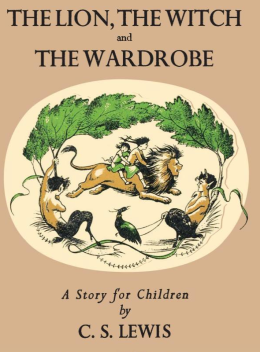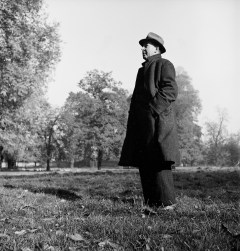
I have a funny sort of personal connection to C.S. Lewis, who died 50 years ago today. It’s through my mother: she was born in London and is just old enough to remember the Blitz, and like the Pevensie children in The Lion, the Witch and the Wardrobe, she was sent to the countryside to escape the bombing. Unlike them, she was so naughty that her host family sent her back to London—apparently whatever she did was bad enough that being bombed by Hitler was considered a suitable punishment.
Later, when she was a student at Oxford, my mother was on her way to her senior exams, and she stopped off at a pub, the Eagle and Child, as one does, to marshal her resources. The Eagle and Child — better known as the Bird and Baby — was of course Lewis’s pub, and there he was at the bar. When she told him where she was headed, he suggested she have a brandy.
She claims she doesn’t remember much after that, but she graduated with high marks, so maybe his suggestion was a good one.
I first read The Lion, the Witch and the Wardrobe — the first installment in Lewis’ seven-part Chronicles of Narnia — when I was eight, and its effect on me was profound. That was the book that taught me what novels were: how they worked and what they were for, namely to whirl you out of this world in a storm of words and take you somewhere gloriously vivid and interesting, where, through some mysterious Deeper Magic, you learned something important about the world you’d just left. It is, apart from everything else, an allegory of reading itself: the wardrobe’s doors open like the cover of a book, allowing Lucy to disappear inside, like a reader into a novel, or at least a good one, which The Lion, the Witch and the Wardrobe surely is.
Because he wrote fantasy, and (worse yet) children’s fantasy, Lewis isn’t much praised as a craftsman of prose. But reread those opening pages: they hold up as many children’s fantasies don’t, and their stylistic influence is as broad and deep as anything by Lewis Carroll or Tolkien. Look, just from a technical standpoint, at how he brings Lucy through the wardrobe, from our world into Narnia:
Soon she went further in and found that there was a second row of coats hanging up behind the first one. It was almost quite dark in there and she kept her arms stretched out in front of her so as not to bump her face into the back of the wardrobe. She took a step further in – then two or three steps — always expecting to feel woodwork against the tips of her fingers. But she could not feel it.
“This must be a simply enormous wardrobe!” thought Lucy, going still further in and pushing the soft folds of the coats aside to make room for her. Then she noticed that there was something crunching under her feet. “I wonder is that more moth balls?” she thought, stooping down to feel it with her hands. But instead of feeling the hard, smooth wood of the floor of the wardrobe, she felt something soft and powdery and extremely cold. “This is very queer,” she said, and went on a step or two further.
Notice the economy of it, the crispness, the precision, the specificity: there’s no light show, no Vaseline on the lens, no swelling orchestra, no purple prose, just a simple series of concrete details that, via some miraculous sleight of hand, takes us from one world into another. This is how every serious fantasist has done it since Lewis, from Ursula Le Guin to Neil Gaiman to Philip Pullman to George R.R. Martin to Susanna Clarke; no one had done it before him.

C.S. Lewis standing near Magdalen College, Oxford University, 1946
Every reader of Lewis has had to come to a reckoning with him, a renegotiation of terms, as he or she has grown up. (There is an entire marvelous book about this process – The Magician’s Book, by Laura Miller – which is indispensable to any passionate Narnian.) I’m not among those who are bothered by Lewis’s Christian apologetics: I was raised in a household virtually without religion, so I don’t really have any nerves to touch on that score. I was more troubled by Aslan’s role in the Narnian cosmos. Why does he allow so much evil to befall his people? Why, for example, in Prince Caspian, does he spend so much time playing peekaboo with Lucy while Narnians are suffering and dying?
That tension — the fact that Narnia is a world with a living, present god in it, and a world with evil and suffering in it — didn’t cause me to give up on Lewis. It made me want to talk back to him, through my own novels, as Pullman does, and any number of other writers besides. It’s a sign of Lewis’ greatness that, although he’s been dead for a half a century, people still need to talk to him: to ask him questions, to air their grievances, to share his sense of wonder, and to tell him stories the way he told us stories. If there’s any Deeper Magic in this fallen, Aslan-less world, that is it.
TIME book critic Lev Grossman is the author of the fantasy novels The Magicians (2009) and The Magician King (2011).

